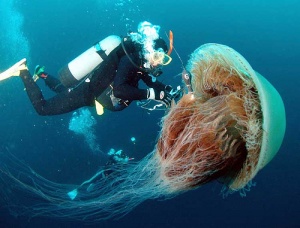Cyanea capillata, or better known as the Lion's Mane jellyfish (jellyfish lion hair) - has tentacles form unique, almost like a lion hair, many, thin and light colored. The color of this jellyfish as a whole varies, usually transparent with the color a bit brighter but with dark stripes on the hood.
Lion's Mane jellyfish
Cyanea capillata live in cold and temperate oceans generally found at depths of 20 m, where increasingly the place of his life, the greater its size. While living in warm temperate regions, are generally not very large, with long tentacles approximately 30 cm. Jellyfish is moving slowly near the surface. Usually live in the area of high seas and very rarely seen in coastal areas.
Cyanea capillata included in the carnivores, which usually eat shrimp, fish, and even other jellyfish. Well, if fitting swim suddenly see a similar fibers yellowish-brown hair like a lion, then it is better to avoid. Cyanea capillata tentacles are long stringy it turned out to contain toxins that are commonly used to immobilize prey. Although, perhaps, does not cause death in humans, but if not immediately treated or mishandled, it can cause a fatal kelupuhan. Mane can just stick on the body and cause extreme pain. At first the pain will be felt in the chest and make the heart beat very fast, followed by pain all over his body due to puncture of tiny dots that like hot needles that penetrate the skin to the nerves. Scar itself will be colored purple and scar-like lashes. But when considered more carefully, the wounds are actually a combination of the little dots, called pistulla, with different depths.
Cyanea capillata
Cyanea capillata is the biggest jellyfish known to man. Hood average diameter of 1 meter by 10 meter long tentacles. In fact, never found Cyanea capillata hood measuring 2.5 meters long tentacles that reach 36.5 meters!! In fact, the blue whale the largest animal that is claimed as the world's wrote, the length of "only" about 32 meter. Spectacular jellyfish is found in Massachusetts bay, Alaska, in 1870.

